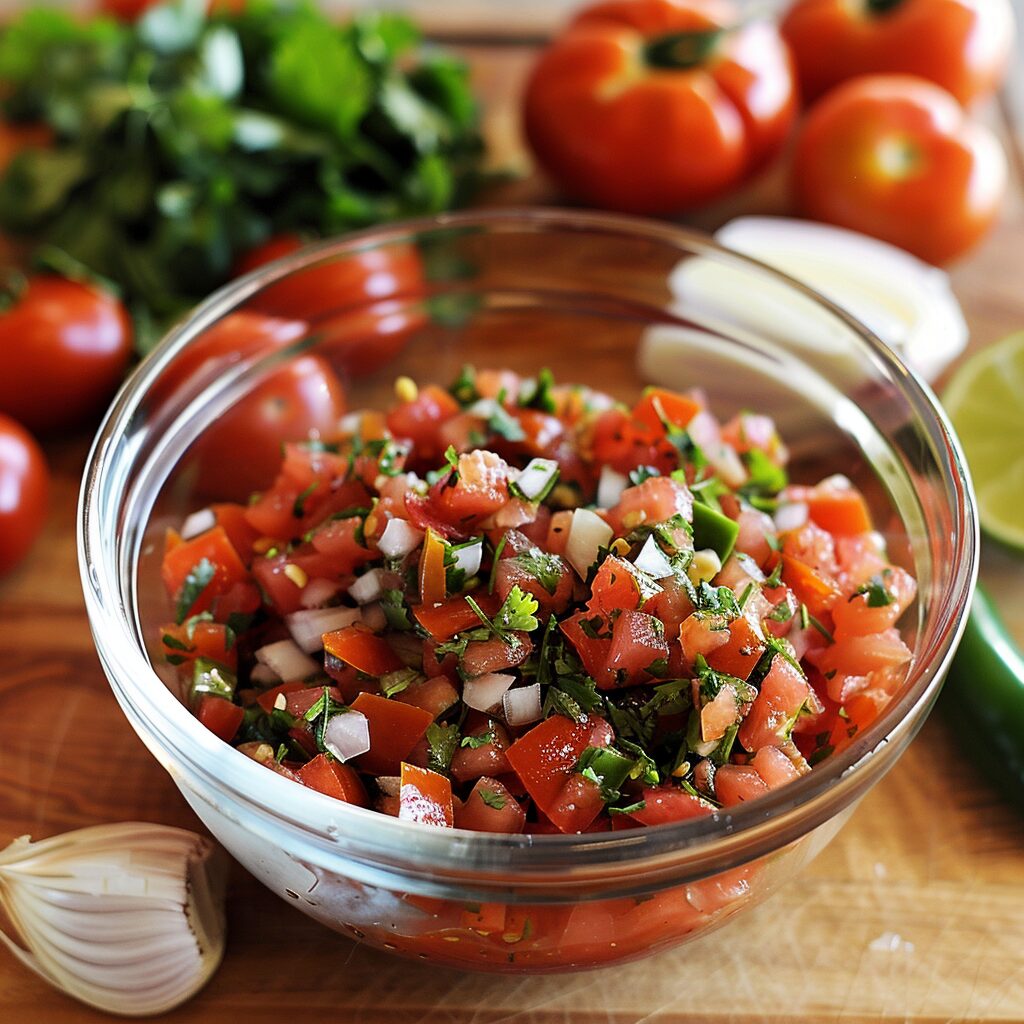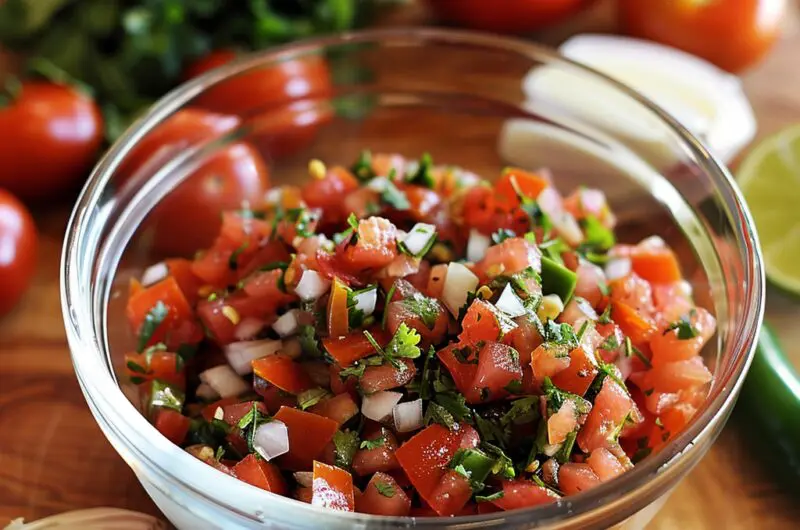Homemade salsa is a culinary delight that can transform any meal into a fiesta of flavors. However, even the most enthusiastic home cooks often stumble upon a common pitfall that can turn their salsa from sensational to subpar. The secret to perfect homemade salsa lies in the details, and one mistake, in particular, can make or break your recipe. Today, we’re going to explore this critical error and provide you with the knowledge to create salsa that will have your friends and family begging for more.
The Tomato Dilemma: Choosing Wisely
The foundation of any great salsa is the tomato, and this is where many salsa enthusiasts go wrong. Using the wrong type of tomatoes can lead to a watery, flavorless mess that fails to capture the essence of authentic Mexican salsa. When selecting tomatoes for your homemade salsa, it’s crucial to opt for varieties that offer the perfect balance of flavor and texture.
For a chunky, restaurant-style salsa, Roma tomatoes are your best bet. These oblong beauties are less watery and have a meatier texture, making them ideal for holding up in a chunky mix. If you’re aiming for a smoother, more sauce-like consistency, consider using ripe beefsteak tomatoes. Their larger size and juicier nature blend well, creating a luscious base for your salsa.
Avoid using watery tomatoes like heirlooms or cherry tomatoes in your salsa. While delicious in salads, these varieties can quickly turn your salsa into a soupy disaster. The excess moisture they release will dilute the flavors and ruin the consistency you’re aiming for.
Tip: For the best results, choose tomatoes that are ripe but still firm to the touch. This ensures optimal flavor without compromising texture.
Once you’ve selected the perfect tomatoes, it’s time to address another common mistake: failing to remove the seeds. The pulpy seeds of tomatoes contain a significant amount of water, which can make your salsa too thin. Take the extra time to de-seed your tomatoes before chopping them. This simple step will dramatically improve the consistency of your salsa and allow the other flavors to shine through.
To properly de-seed tomatoes, cut them into quarters and use a spoon or your fingers to gently scoop out the seeds and surrounding gel. Don’t worry about losing flavor – the real taste is in the flesh of the tomato. This process might seem tedious, but the result is well worth the effort.
Balancing Act: The Importance of Acidity
Another crucial aspect of perfect salsa that often gets overlooked is the balance of acidity. Many home cooks make the mistake of either omitting acid altogether or using the wrong amount. Acidity is vital in salsa as it brightens the flavors, balances the sweetness of the tomatoes, and helps to preserve the freshness of your creation.
The most common sources of acidity in salsa are citrus fruits like limes or lemons, and vinegar. Lime juice is particularly popular in Mexican cuisine and adds an authentic touch to your salsa. However, be cautious not to overdo it. Too much acidity can overpower the other flavors and make your salsa unpleasantly tart.
Start by adding a small amount of lime juice or vinegar to your salsa, then taste and adjust as needed. Remember, you can always add more, but you can’t take it out once it’s mixed in. If you find your salsa is too acidic, you can balance it out by adding a pinch of sugar or a bit more salt.
Tip: For a unique twist, try using a combination of lime juice and a splash of orange juice. This adds complexity to the flavor profile and a subtle sweetness that complements the heat of the peppers.
Speaking of heat, let’s address another common salsa faux pas: the pepper predicament. While jalapeños are a classic choice for adding spice to your salsa, don’t be afraid to experiment with other varieties. Serrano peppers offer a clean, bright heat, while habaneros bring intense flavor along with their fiery kick.
The Secret Ingredient: Time
Now, we’ve arrived at what might be the most overlooked aspect of creating spectacular homemade salsa – the importance of marination time. Many eager salsa makers rush to serve their creation immediately after mixing, missing out on the magical transformation that occurs when you allow the ingredients to mingle and meld.
Letting your salsa sit for at least an hour before serving allows the flavors to develop and intensify. During this time, the salt draws out moisture from the vegetables, creating a more cohesive texture. The acidity from the lime juice or vinegar begins to “cook” the onions slightly, mellowing their sharp bite. And most importantly, all the different flavor components – the sweetness of the tomatoes, the heat of the peppers, the freshness of the cilantro – start to harmonize into a symphony of taste.
For the best results, consider making your salsa the day before you plan to serve it. This extended marination time will result in a salsa that’s bursting with flavor and perfectly balanced. Just be sure to store it in an airtight container in the refrigerator to maintain freshness.
Tip: If you’re short on time, you can speed up the marination process by gently heating your salsa in a saucepan over low heat for about 10 minutes. This will help the flavors meld more quickly, though it will slightly change the texture of your salsa.
To truly elevate your salsa game, consider investing in a quality food processor. While hand-chopping ingredients can result in a rustic, chunky salsa, a food processor allows you to achieve a more consistent texture and blend flavors more thoroughly. Plus, it significantly cuts down on preparation time, making homemade salsa a quick and easy addition to any meal.
Remember, the key to great salsa lies not just in the ingredients, but in the preparation and patience. By choosing the right tomatoes, balancing your flavors carefully, and allowing time for marination, you’ll create a salsa that rivals any restaurant offering. So the next time you’re tempted to rush your salsa or cut corners, remember that the extra effort and waiting time will reward you with a bowl of zesty, flavorful goodness that will have everyone coming back for more.
In the end, making perfect homemade salsa is an art form that requires attention to detail and a willingness to experiment. By avoiding the common mistakes we’ve discussed and embracing the secrets of great salsa-making, you’ll be well on your way to becoming a salsa master. So grab those tomatoes, sharpen your knife, and get ready to create a salsa that will make your taste buds dance with joy. Your homemade salsa journey starts now – and trust us, it’s going to be delicious!
Perfect Homemade Salsa
Course: AppetizerCuisine: Mexican4
servings30
minutes40
minutes300
kcalDiscover the secrets to creating a zesty, flavor-packed salsa that will elevate your Mexican cuisine game!
Ingredients
4 large Roma tomatoes, deseeded and diced
1/2 medium white onion, finely chopped
2 jalapeño peppers, deseeded and minced
1/4 cup fresh cilantro, chopped
2 cloves garlic, minced
2 tablespoons fresh lime juice
1 tablespoon white vinegar
1 teaspoon sea salt
1/4 teaspoon ground cumin
Directions
- Begin by preparing your tomatoes. Cut them into quarters and carefully remove the seeds and pulp. This step is crucial for preventing your salsa from becoming too watery. Once deseeded, dice the tomatoes into small, uniform pieces.
- In a large bowl, combine the diced tomatoes with the finely chopped white onion. The onion provides a sharp, crisp flavor that complements the sweetness of the tomatoes. Make sure to chop the onion finely to ensure it distributes evenly throughout the salsa.
- Add the minced jalapeño peppers to the bowl. For a milder salsa, remove the seeds and membranes before mincing. If you prefer more heat, leave some or all of the seeds in. Remember, you can always add more heat, but you can’t take it away, so start conservatively if you’re unsure.
- Stir in the chopped fresh cilantro and minced garlic. The cilantro adds a bright, fresh flavor that’s characteristic of Mexican cuisine, while the garlic provides depth and complexity to the salsa. If you’re not a fan of cilantro, you can reduce the amount or substitute with fresh parsley.
- Now it’s time to add the liquid ingredients. Pour in the fresh lime juice and white vinegar. These acidic components not only enhance the flavors but also help to preserve the salsa, extending its freshness. The acidity also balances the sweetness of the tomatoes and the heat of the peppers.
- Sprinkle in the sea salt and ground cumin. The salt will draw out moisture from the vegetables and intensify the overall flavor, while the cumin adds a subtle earthy note that’s quintessential to Mexican cuisine. Mix all ingredients thoroughly, ensuring everything is well combined.
- Cover the bowl with plastic wrap or transfer the salsa to an airtight container. Place it in the refrigerator and let it marinate for at least one hour. This resting period allows the flavors to meld together and develop, resulting in a more cohesive and flavorful salsa.
- After marinating, taste your salsa and adjust the seasonings if necessary. You might want to add more salt, lime juice, or jalapeño depending on your preference. Remember, the flavors will continue to develop over time, so it’s okay if it’s not perfect right away.
Notes
- For best results, use ripe but firm Roma tomatoes. They have less water content and will give your salsa a better consistency.
- If your salsa is too watery after mixing, you can strain some of the liquid or add a small amount of tomato paste to thicken it.
- This salsa will keep in the refrigerator for up to 5 days when stored in an airtight container.
Frequently Asked Questions
Q: How long does homemade salsa last in the refrigerator?
A: When stored in an airtight container in the refrigerator, homemade salsa typically lasts for 5-7 days. The high acidity from the tomatoes, lime juice, and vinegar helps preserve the salsa. However, always check for any signs of spoilage before consuming.
Q: Can I freeze homemade salsa?
A: Yes, you can freeze homemade salsa, but the texture may change slightly upon thawing. To freeze, place the salsa in an airtight container or freezer bag, leaving about an inch of space at the top for expansion. Frozen salsa can last up to 3-4 months. Thaw it in the refrigerator before using.
Q: How can I make my salsa less watery?
A: To make your salsa less watery, make sure to remove the seeds and pulp from the tomatoes before dicing. You can also let the diced tomatoes drain in a colander for about 30 minutes before mixing with other ingredients. If your salsa is still too watery, you can strain some of the liquid or add a small amount of tomato paste to thicken it.
Q: Can I use canned tomatoes instead of fresh ones?
A: Yes, you can use canned tomatoes, particularly if fresh tomatoes are out of season. Opt for whole peeled tomatoes and drain them well before using. Keep in mind that the texture and flavor might be slightly different from fresh tomatoes. You may need to adjust the amount of salt and acid (lime juice or vinegar) when using canned tomatoes.


